Easy at Home Drug Test Thc How to Read
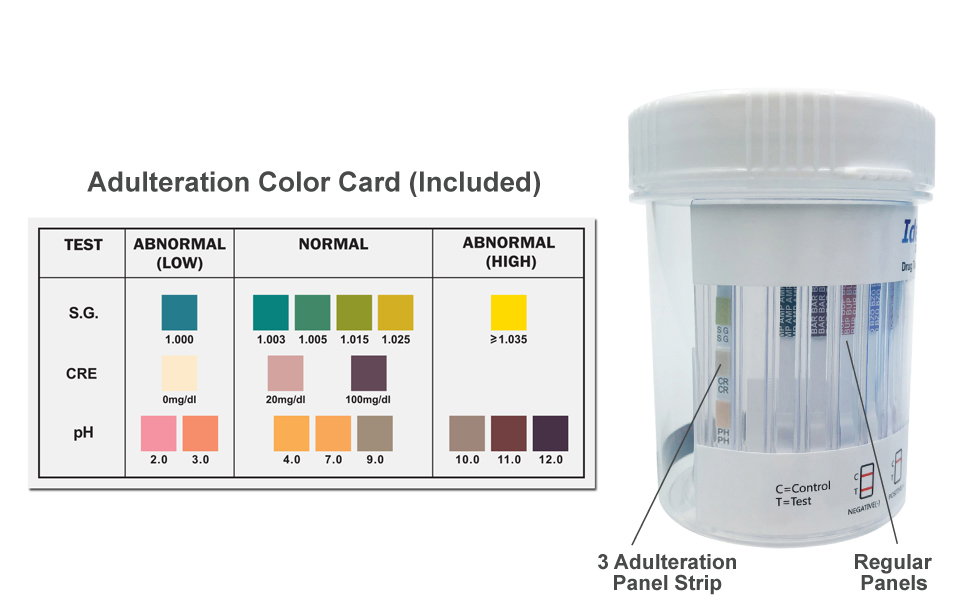
Test Quick Guide
Drug testing detects whether a person has used certain prescription, over-the-counter, or illegal drugs. At-home drug tests can screen for traces of these substances in various samples such as urine, saliva, breath, or hair to provide information about recent drug use.
Testing for drug use at home typically involves several steps. An initial screening drug test offers preliminary results about whether a substance was detected. If test results are positive, follow-up testing by a doctor is needed to confirm positive test results.
"Drug tests can help identify any harmful drugs that may be in someone's system," says Victoria Glass, M.D., a practicing doctor with a focus on medical research. "And it can help identify the early signs of addiction or abuse."
The FDA says it's very important to get confirmation of a positive result through laboratory testing because certain foods, drinks, supplements and medications can affect the results of an at-home drug test.
Physician-ordered laboratory tests are the most accurate way to detect evidence of drug use. While at-home testing may provide helpful information, using an at-home drug test is not a replacement for testing performed at a laboratory or doctor's office.
The Best At-Home Drug Tests Compared
| Test | Price | Type | Tests for: | Results in: | Insurance accepted? | Who should use it: |
|---|---|---|---|---|---|---|
| Identify Diagnostics – 12 Panel Drug Test Cup – best overall | $30.31 for 5 cups on Amazon | Self-collection of urine |
| 5 minutes | No | Adults who want to test for 12 common substances. |
| [email protected] – 5 Panel Instant Drug Test Kit — best for affordability | $12.99 for a 5 pack on Amazon | Self-collection of urine |
| 5 minutes | No | Adults looking for an affordable at-home drug test option. |
| Areta – 14 Panel Drug Test Cup Kit — best for number of drugs tested | $25.89 for 5 cups on Amazon | Self-collection of urine |
| 5 minutes | No | Individuals who want a comprehensive drug test with quick and easy-to-read results. |
| Exploro – Highly Sensitive THC Test — best for THC | $10.76 for 15 strips on Amazon | Self-collection of urine |
| 5 minutes | No | Anyone looking for a THC at-home drug test, especially if you're interested in regular at-home testing. |
About At-Home Drug Tests
Purpose of at-home drug tests
The purpose of drug testing is to determine if there's been recent use of illegal, prescription, or over-the-counter drugs. Drug testing may be performed for a variety of reasons, including:
- Legal or forensic testing
- Drug treatment programs
- Athletic testing
- Medical testing
- Monitoring for prescription drug misuse
- Military testing
There are several options when looking for evidence of drug use, including physician-ordered and at-home drug tests. The following sections provide further information about both at-home and physician-ordered options.
What do the tests measure?
Many types of drugs can be detected through at-home drug testing. Test options vary in the drug(s) they look for as well as the sample used for testing.
Some at-home drug tests identify the drug itself while other tests check for drug metabolites, which are byproducts that remain as the drug is broken down in the body.
Drug tests can detect evidence of drug use only within a specific time frame that can range from minutes after exposure to several days, weeks, or months. This period of time, called a detection window, depends on several factors, including:
- The type of drug
- The amount and frequency of use
- The type of sample being tested
- The rate at which the drug is metabolized and eliminated from the body
At-home drug tests are available that detect a wide variety of illegal, over-the-counter, and prescription drugs including:
- Alcohol
- Nicotine
- Amphetamines
- Barbiturates
- Benzodiazepines
- Cocaine
- Marijuana
- Opioids
- Phencyclidine (PCP)
At-home drug tests may focus on only one drug of concern or can test for several drugs simultaneously in a panel test. There are many different drug panels available for at-home use. One such panel, the 10-panel drug test is available as an at-home kit and detects 10 commonly abused drugs.
Which at-home drug test should I choose?
There are a variety of options for at-home drug testing, including tests that use samples of urine, saliva, breath, or hair.
Urine drug tests are the most common way to look for evidence of drug use at home. At-home urine testing involves collecting urine in a container and testing it using a paper test strip, cassette, or other device according to instructions contained in the package.
Saliva drug tests, also called oral fluid drug tests, are less common but offer a non-invasive option for saliva sample collection. These tests are conducted in a manner similar to urine drug tests.
At-home breathalyzers are small devices that use a sample of air exhaled from the lungs to estimate the amount of alcohol in the blood, called blood alcohol content (BAC). While breathalyzers provide quick estimates of alcohol use, they are not as accurate as drawing a blood sample and performing alcohol blood tests, so confirmation testing may be needed.
Hair follicle drug tests have a longer detection window than other types of drug tests. A standard sample of hair from the scalp has a detection window of up to 90 days. Hair samples can also be taken from other parts of the body where hair grows more slowly, providing a detection window of up to 12 months.
In the following sections, you can find information about several at-home urine drug tests that are currently available.
Benefits and Downsides of At-Home Drug Tests
At-home drug testing offers both pros and cons compared to tests conducted in a medical setting. Consider the following benefits and downsides of at-home drug testing when deciding if this approach is right for you.
Potential benefits of at-home drug testing include:
- Convenience: At-home drug tests are generally convenient, allowing you to look for evidence of a variety of drugs without having to make an appointment at a laboratory or testing facility.
- Noninvasive collection: Collecting a sample of urine, saliva, breath, or hair for at-home drug testing is easy and doesn't require the monitoring or strict protocols that are used for laboratory-based tests.
- Quick Results: If you're looking for preliminary drug test results, there are numerous options for rapid, self-test kits that provide results in a matter of minutes.
Some of the potential downsides of at-home drug testing include:
- Requires confirmation testing: A self-test does not provide definitive results and inaccurate results do occur. When purchasing an at-home drug test, it's important to see if the test includes laboratory-based confirmation testing. Many self-test kits don't provide this service and only offer preliminary results.
- Doesn't test for all drugs: Drug testing is complex, and no single drug test can look for all potential drugs of abuse. Additionally, newer and less common drugs may not be detectable using at-home drug tests.
- Not recommended for minors: Testing a child or adolescent for drug use is not recommended by expert groups like the American Academy of Pediatrics. There isn't enough evidence that at-home drug testing reduces drug use in minors. This option also comes with risks such as misinterpreting test results and damaging the relationship between children and their parents.
If you're considering using an at-home drug test, your doctor can review these pros and cons with you to help decide what testing option best matches your needs.
The Best At-Home Drug Tests
There are many different types of at-home drug tests available, and it's important to consider what type of drug testing you're looking for when selecting an at-home drug test. The following sections provide information about top picks for at-home drug testing:
Methodology
At-home drug tests were reviewed based on value, convenience, and availability of tests. These overall factors are based on data including price, insurance acceptance, comprehensiveness of tests, and how quickly you can get results and speak to a doctor. Drug test selections have been screened by Testing.com's Medical Review Board.
Best Overall
Identify Diagnostics – 12 Panel Drug Test Cup
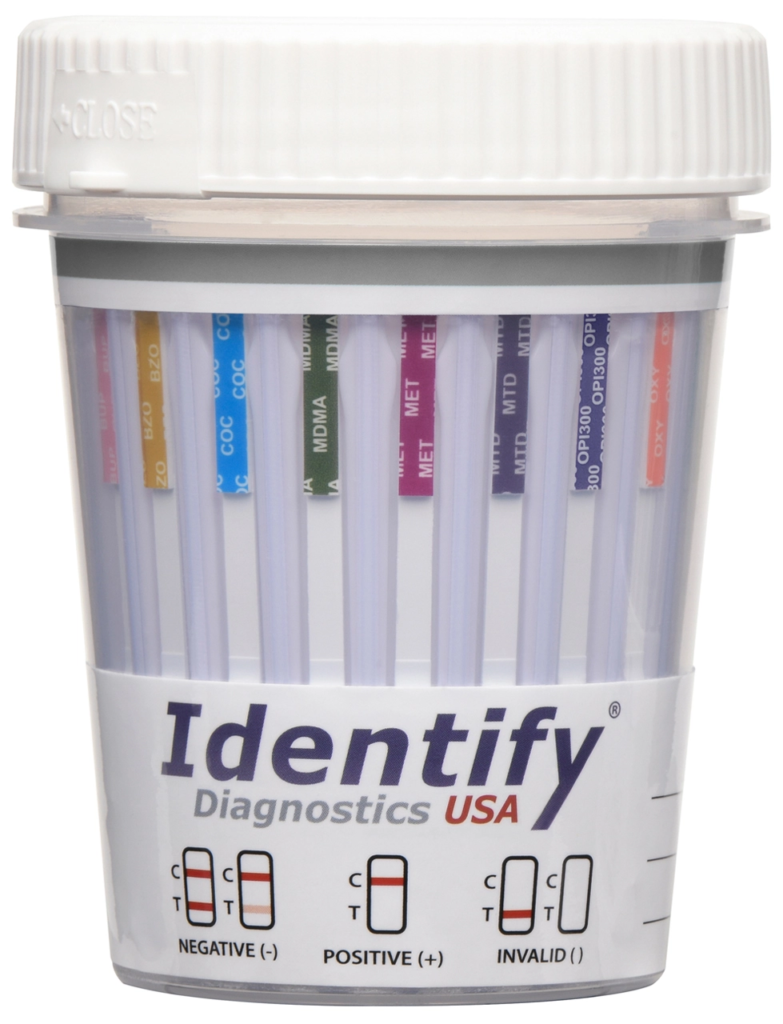
| Price: | $30.31 for 5 cups on Amazon |
| Type: | Self-collection |
| Sample: | Urine |
| Tests for: |
|
| Results timeline: | 5 minutes |
| Accuracy: | CLIA Waived/510k Cleared |
| Accepts insurance: | No |
| Physician follow up: | No |
| Prescriptions offered: | No |
With its simple design, built-in temperature strip, and ability to detect a broad range of drugs, the 12 Panel Drug Test Cup from Identify Diagnostics is our pick for best overall at-home drug test.
This all-in-one test features a collection cup and drug test strips combined into one device. This means that after collecting a urine sample in the cup, you just screw on the cap and wait to read the results.
Test results are viewable after five minutes using the built-in test strips. The results are only accurate for a short time, so it's important to discard the test after 10 minutes.
Tampering with samples can affect the results of drug tests, so Identity Diagnostics includes a temperature strip that ensures the sample is freshly collected. Within 2 to 4 minutes of collection, the temperature strip should register between 90 and 100 degrees Fahrenheit.
Test kits are available from a variety of retailers in several quantities, from 5-packs all the way up to boxes of 200 tests.
| What's great about Identify Diagnostics' drug test? | What's not so great? |
|---|---|
|
|
Why is Identify Diagnostics' at-home drug test the best overall?
Identify Diagnostics 12-Panel Drug test is easy and comprehensive, testing for 12 different substances in five minutes with over 99% accuracy.
Who should use Identify Diagnostics' at-home drug test?
Individuals or businesses looking for a tamper-proof, quick and easy at-home drug test for 12 common substances.
Best for Affordability
[email protected] – 5 Panel Instant Drug Test Kit
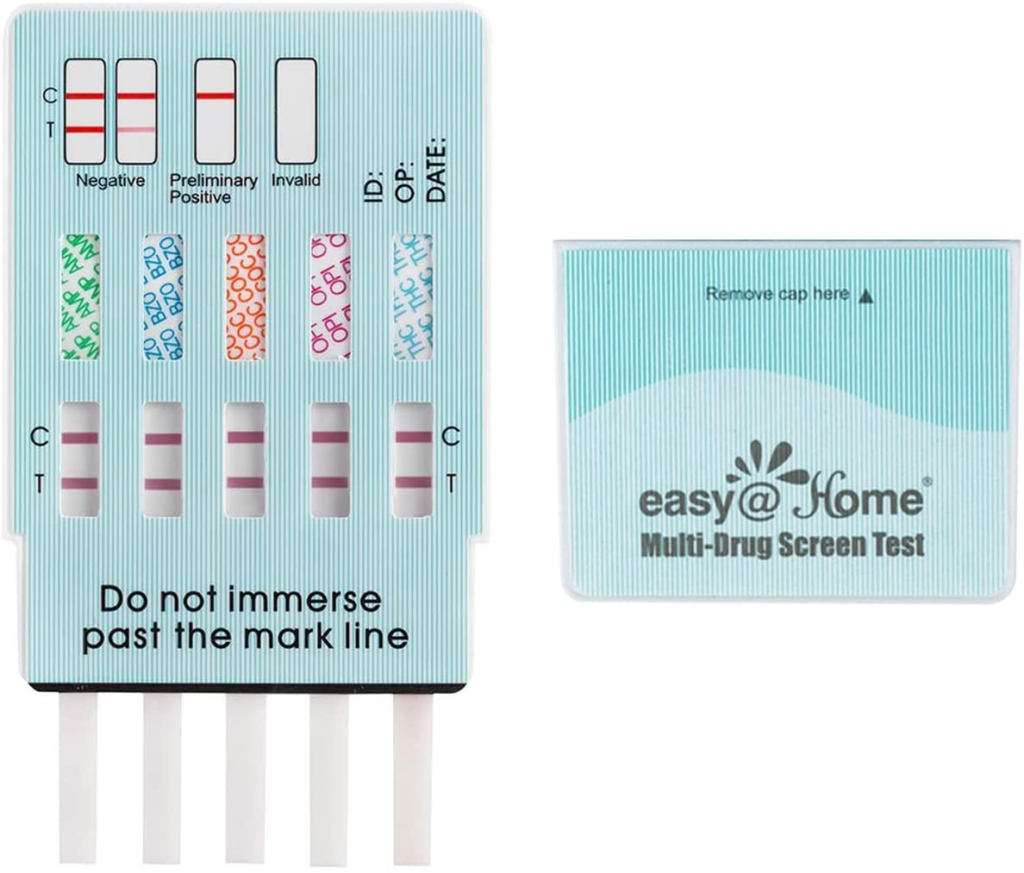
| Price: | $12.99 for a 5 pack on Amazon |
| Type: | Self-collection |
| Sample: | Urine |
| Tests for: |
|
| Results timeline: | 5 minutes |
| Accuracy: | CLIA waived and510k cleared for home use |
| Accepts insurance: | No |
| Physician follow up: | No |
| Prescriptions offered: | No |
The 5 Panel Instant Drug Test Kit from [email protected] is our pick for the most affordable at-home drug test. The test combines simplicity, accuracy, and a 100% satisfaction guarantee, allowing you to conduct regular drug testing without breaking the bank.
This test has been cleared for at-home use by the FDA and has also received a federal waiver for professional use in laboratories. As with any at-home drug test, it's important to remember that results are preliminary and should be confirmed by an additional lab-based test.
To conduct the test, start by collecting a small amount of urine in a clean collection cup. Then open the sealed pouch containing the test panel and remove the cap that protects the absorbent end. Submerge that end in the urine sample, making sure not to immerse it past the max fill line. Leave the absorbent end of the test panel in the sample for exactly 10 seconds, then lay the test flat on a clean, dry surface. Note that this procedure is a bit less secure than the one used by Identify Diagnostics, which was entirely self-contained in the collection cup.
After five minutes, the results can be interpreted based on instructions provided in the test kit. Don't try to read the results beyond the five-minute mark, as they may become inaccurate after this point. If you have any questions while conducting the test, [email protected] responds to inquiries by email or through its toll-free customer service line.
| What's great about [email protected]'s drug test? | What's not so great? |
|---|---|
|
|
Why is [email protected]'s at-home drug test the best for affordability?
[email protected]'s 5 Panel Instant Drug Test Kit is the most affordable option on our list and comes with a 100% satisfaction guarantee, so if you try it and don't like it, you can get your money back.
Who should use [email protected]'s at-home drug test?
Adults looking for an affordable at-home drug test option.
Best for the Number of Drugs Tested
Areta – 14 Panel Drug Test Cup Kit
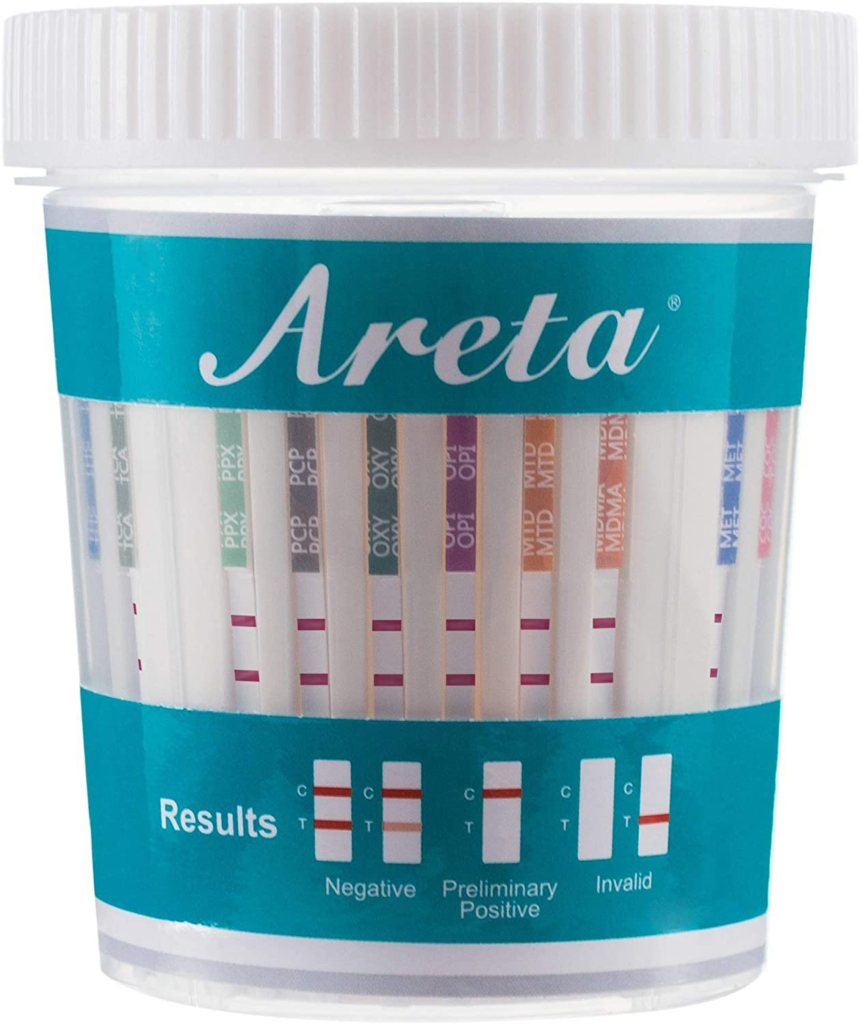
| Price: | $25.89 for 5 cups on Amazon |
| Type: | Self-collection |
| Sample: | Urine |
| Tests for: |
|
| Results timeline: | 5 minutes |
| Accuracy: | 510(k) cleared for Home Use (OTC Use), CLIA Waived for professional use, made in an ISO certified manufactured facility, and uses the same science as lab screening tests; meets SAMHSA standards for most panels |
| Accepts insurance: | No |
| Physician follow up: | No |
| Prescriptions offered: | No |
Areta's 14 Panel Drug Test Cup Kit is our pick for the most comprehensive drug test. In addition to the drugs typically included in smaller test panels, this kit includes testing for propoxyphene (an opioid pain reliever) and tricyclic antidepressants.
The test kit includes instructions, a urine collection cup, and a set of disposable plastic gloves. Testing is straightforward: just remove the cap, collect fresh urine in the collection cup, and read the results on the side of the cup after five minutes. To ensure that the urine sample is fresh, the collection cup includes a temperature strip.
Lines appear on the test strip for each drug being measured. If two lines appear, including two faint lines, the test is negative. If only the control line appears, the test is positive.
Areta's 14 Panel Drug Test Cup Kit is more than 99% accurate. It has been cleared by the FDA for home use and has a Clinical Laboratory Improvement Amendments waiver for professional use. It also meets the Substance Abuse and Mental Health Services Administration (SAMHSA) standards for most drug panels.
| What's great about Areta's drug test? | What's not so great? |
|---|---|
|
|
Why is Areta's at-home drug test the best for the most drugs?
The Areta 14 Panel Drug Test Cup Kit is the most comprehensive drug test kit on this list and boasts more than 99% accuracy.
Who should use Areta's at-home drug test?
Individuals who want a comprehensive drug test with quick and easy-to-read results.
Best for THC
Exploro – Highly Sensitive THC Test
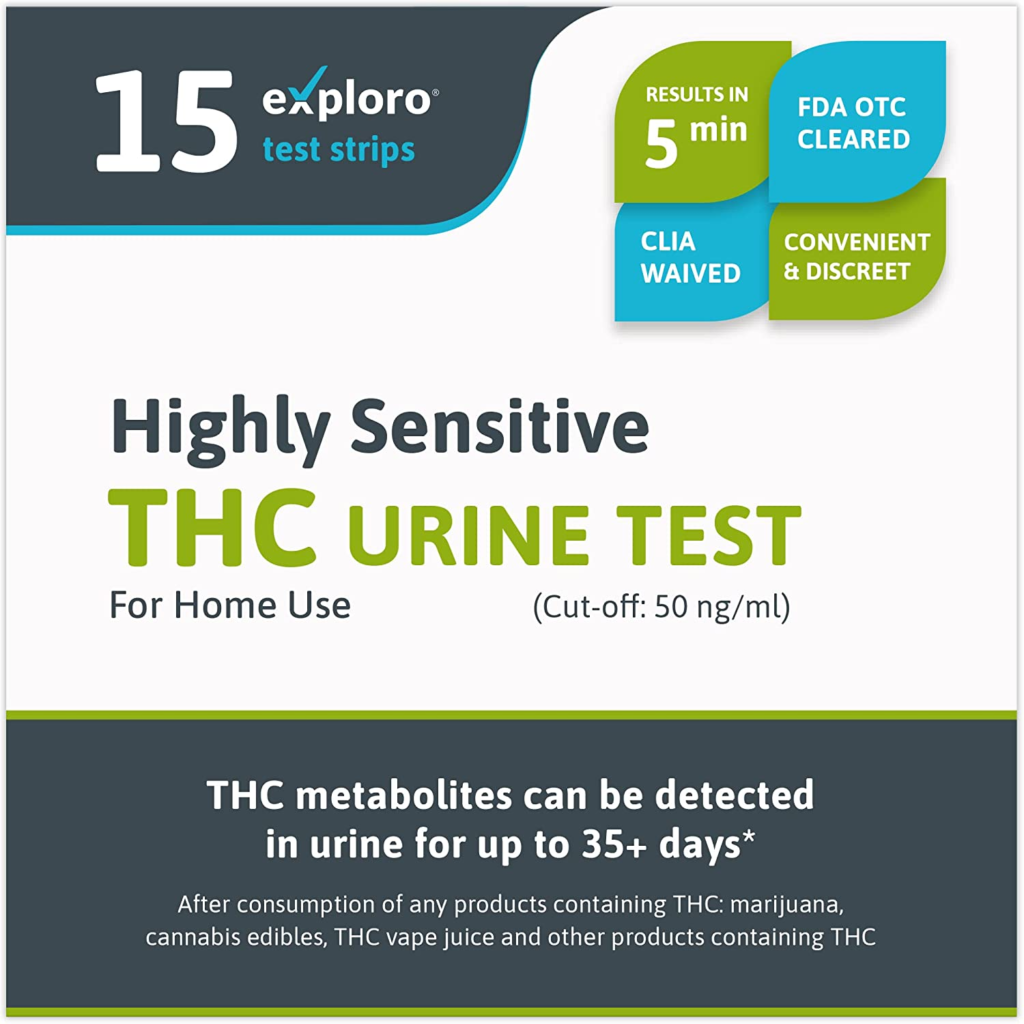
| Price: | $10.76 for 15 strips on Amazon |
| Type: | Self-collection |
| Sample: | Urine |
| Tests for: |
|
| Results timeline: | 5 minutes |
| Accuracy: | 510(k) cleared for at-home use and CLIA waived for professional use |
| Accepts insurance: | No |
| Physician follow up: | No |
| Prescriptions offered: | No |
If you're only interested in testing for marijuana, the FDA-cleared Exploro Highly Sensitive THC Test does just that. It can detect THC metabolites in urine for up to 35 days.
As the name suggests, this test is highly sensitive to tetrahydrocannabinol (THC), the main psychoactive ingredient of marijuana, and displays a positive reading for a THC level of 50 nanograms per milliliter or higher. This cutoff is the same level used in federal drug-free workplace programs for initial drug screenings.
To use the Exploro Highly Sensitive THC Test, dip one of the provided test strips into a sample of urine, immersing it up to the max fill line. Results are displayed within five minutes and can be interpreted according to instructions provided in the test kit.
If you'll be testing for THC regularly, Exploro also offers bulk packages of 25 test strips. Each strip has a shelf life of 24 months.
| What's great about Exploro's drug test? | What's not so great? |
|---|---|
|
|
Why is Exploro's at-home drug test the best for THC?
Exploro's THC test can detect THC metabolites in urine at the same level as federal drug-free workplace programs.
Who should use Exploro's at-home drug test?
Anyone looking for a THC at-home drug test, especially if you're interested in regular at-home testing.
Interpreting At-Home Drug Test Results
Interpreting the results of your at-home drug test depends upon the type of test used and whether the at-home test kit included laboratory confirmation testing.
For self-test kits and other at-home drug tests that do not include confirmation testing, results are often interpreted by checking the test strip for the presence of a colored band according to instructions in the test package. Possible test results include:
- Positive: A positive result on an initial drug test provides only preliminary evidence of drug use and requires confirmation testing. A positive result does not mean that you are currently intoxicated or have a substance use disorder.
- Negative: A negative result indicates that no evidence of drug use was detected in the sample. A negative test applies only to the drugs included in the test. A negative result can occur if you aren't using drugs, if you last used a drug outside of the timeframe of the detection window, or if the test kit was expired.
- Invalid: Self-test kits usually have a way of indicating invalid test results. In many tests, checking the validity of the test result requires looking for the presence of a specific colored band on the test strip.
For self-collection kits and other at-home drug tests that include confirmation testing, test results are provided by the laboratory. Results often include information about the specific test conducted, the amount of a substance that was found, and the laboratory's interpretation. Interpretations of laboratory test results include:
- Positive: A positive test result means that the confirmation testing found levels of drugs or drug metabolites in the sample that were above the laboratory's established cutoff value. A positive result typically specifies which drug or drugs were detected in the sample.
- Negative: A negative confirmation test indicates that no evidence of the drug use was found or that the amount of drugs or their metabolites did not exceed the laboratory's established cutoff value. As with initial testing, a negative confirmation test may indicate that you haven't used the drugs included in the test or that you last used drugs outside of the detection window.
- Invalid: An invalid result means that the test was not able to identify whether drugs were present in the sample. Invalid results may be reported for many reasons including evidence of tampering or adulteration that occurred during the collection process. Many laboratories provide information about why a test was determined to be invalid.
With self-tests and self-collection tests, there are several factors to consider that can affect the accuracy of the results.
False positive results occur when a drug test is positive even though you haven't used the drug that the test is designed to detect. False positive results may occur because certain foods, beverages, supplements, and medicines can affect test results. For example:
- Consuming poppy seeds may cause false positive results for opioids.
- Taking antidepressants and other medications can cause false positive results for amphetamines or opioids.
- Using cold medicines can cause false positive results for PCP.
- Eating foods containing hemp and taking some over-the-counter nonsteroidal anti-inflammatory drugs (NSAIDs) can cause false positive results for marijuana.
False negative results occur when a drug test is negative even though you have used the drug that the test is designed to detect. False negative results may occur due to improper sample collection, expired test materials, or drug use that falls outside of the test's detection window. Misleading results may also occur due to use of a new or modified version of the drug, or because of tampering in which the test sample is adulterated or substituted before testing.
Another common reason for misleading drug test results is that many tests aren't able to detect all drugs in a certain class. For example, many amphetamine tests aren't able to detect MDMA, MDA or methamphetamine. Other potential drugs of abuse that aren't commonly available in initial drug tests include:
- Meperidine and fentanyl
- Lysergic acid diethylamide (LSD)
- Gamma hydroxybutyrate (GHB)
- Mescaline
- Inhaled hydrocarbons
If you have questions about the accuracy of at-home drug testing, it's important to discuss your concerns with a doctor or health professional who is experienced in interpreting drug test results.
Do I need follow-up tests?
After a self-test or another drug test that doesn't provide confirmation testing, follow-up testing is necessary to confirm positive test results. This is especially important in situations in which a positive test result could negatively affect a person's life, such as in a legal case or employment testing.
If a confirmation drug test is positive, a health professional may follow-up by evaluating the patient for a substance use disorder. An evaluation for a substance use disorder involves asking the patient several questions to assess the pattern and effects of their drug use.
Problematic or unhealthy drug use can lead to a variety of health risks, including addiction. Addiction is a complex disease that is marked by drug-seeking behaviors and drug use that is difficult to control despite negative consequences. Effective treatment is available for drug use and addiction.
Questions for your doctor after at-home drug testing
It may be helpful to consider the following questions when discussing your at-home drug test results with your doctor:
- Can you help me understand the result of my at-home drug test?
- Do you recommend any follow-up or confirmation testing?
- What other reasons could there be for this test result?
View Sources
Berger A. Alcohol breath testing. BMJ. 2002;325(7377):1403. doi:10.1136/bmj.325.7377.1403
Chang G. Alcohol intake and pregnancy. In: Lockwood CJ, Saxon AJ, eds. UpToDate. Updated September 9, 2021. Accessed June 8, 2022.https://www.uptodate.com/contents/alcohol-intake-and-pregnancy
Dasugpta A. Chain of custody for urine drugs of abuse testing. Published January 1, 2019. Accessed June 8, 2022.https://www.aacc.org/cln/articles/2019/janfeb/chain-of-custody-for-urine-drugs-of-abuse-testing
Drug and Alcohol Testing Industry Association. Workplace drug testing. Date unknown. Accessed June 8, 2022.https://datia.memberclicks.net/assets/docs/DATIA%20Tools%20Member%20Forum.pdf
Drummer OH. Drug testing in oral fluid. Clin Biochem Rev. 2006;27(3):147-159.
Hoffman RJ. Testing for drugs of abuse (DOAs). In: Traub SJ, ed. UpToDate. Updated January 15, 2021. Accessed June 8, 2022.https://www.uptodate.com/contents/testing-for-drugs-of-abuse-doas
Levy S, Siqueira LM, Committee on Substance Abuse, et al. Testing for drugs of abuse in children and adolescents. Pediatrics. 2014;133(6):e1798-e1807. doi:10.1542/peds.2014-0865
McNeil SE, Cogburn M. Drug testing. In: StatPearls. Updated August 9, 2021. Accessed June 8, 2022.https://www.ncbi.nlm.nih.gov/books/NBK459334/
MedlinePlus: National Library of Medicine. Drug testing. Updated July 31, 2020. Accessed June 8, 2022.https://medlineplus.gov/lab-tests/drug-testing/
MedlinePlus: National Library of Medicine. Blood alcohol level. Updated December 3, 2020. Accessed June 8, 2022.https://medlineplus.gov/lab-tests/blood-alcohol-level/
National Institute on Drug Abuse. Understanding drug use and addiction. Updated June 2018. Accessed June 8, 2022.https://www.drugabuse.gov/publications/drugfacts/understanding-drug-use-addiction
O'Malley GF, O'Malley R. Drug testing. Merck Manuals Professional Edition. Updated May 2020. Accessed June 8, 2022.https://www.merckmanuals.com/professional/special-subjects/recreational-drugs-and-intoxicants/drug-testing
O'Malley GF, O'Malley R. Drug testing. Merck Manuals Consumer Edition. Updated June 2020. Accessed June 8, 2022.https://www.merckmanuals.com/home/special-subjects/recreational-drugs-and-intoxicants/drug-testing
Price JW. Does performing preplacement workplace hair drug testing influence US department of transportation random and postaccident urine drug test positivity rates?. J Addict Med. 2018;12(2):163-166. doi:10.1097/ADM.0000000000000384
US Department of Health and Human Services. Drug testing resources. Updated October 14, 2021. Accessed June 8, 2022.https://www.samhsa.gov/workplace/resources/drug-testing
US Department of Transportation. What criteria do laboratories use to establish that a specimen is invalid? Updated April 5, 2016. Accessed June 8, 2022.https://www.transportation.gov/odapc/part40/40-96
US Food and Drug Administration. Drugs of abuse (collection kit). Updated September 27, 2018. Accessed June 8, 2022.https://www.fda.gov/medical-devices/drugs-abuse-tests/drugs-abuse-collection-kit
US Food and Drug Administration. Drugs of abuse home use test. Updated September 27, 2018. Accessed June 8, 2022.https://www.fda.gov/medical-devices/drugs-abuse-tests/drugs-abuse-home-use-test
US Preventive Services Task Force. Unhealthy drug use: Screening. Published June 9, 2020. Accessed June 8, 2022.https://www.uspreventiveservicestaskforce.org/uspstf/recommendation/drug-use-illicit-screening
Ask a Laboratory Scientist

Source: https://www.testing.com/tests/at-home-drug-test/